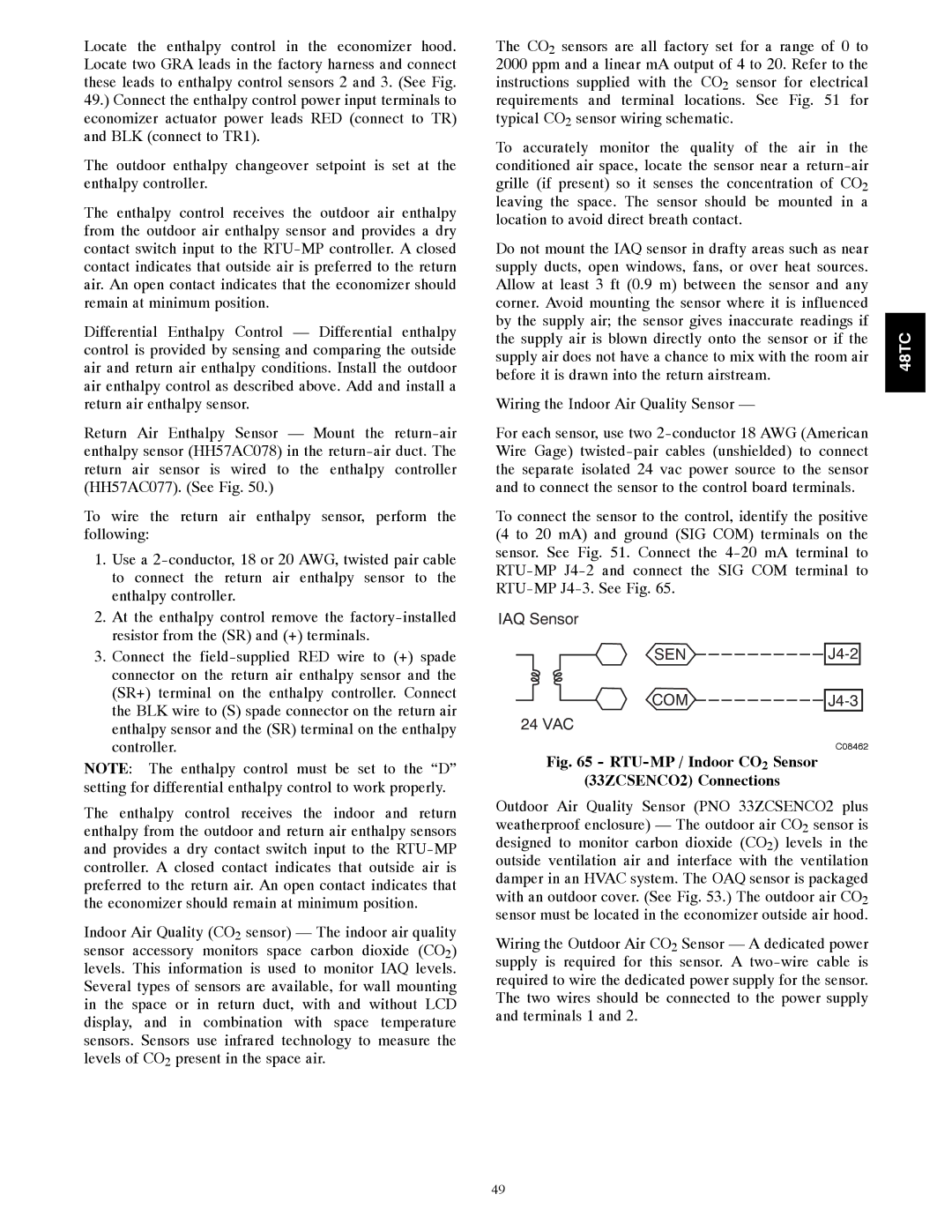
Locate the enthalpy control in the economizer hood. Locate two GRA leads in the factory harness and connect these leads to enthalpy control sensors 2 and 3. (See Fig. 49.) Connect the enthalpy control power input terminals to economizer actuator power leads RED (connect to TR) and BLK (connect to TR1).
The outdoor enthalpy changeover setpoint is set at the enthalpy controller.
The enthalpy control receives the outdoor air enthalpy from the outdoor air enthalpy sensor and provides a dry contact switch input to the
Differential Enthalpy Control — Differential enthalpy control is provided by sensing and comparing the outside air and return air enthalpy conditions. Install the outdoor air enthalpy control as described above. Add and install a return air enthalpy sensor.
Return Air Enthalpy Sensor — Mount the
To wire the return air enthalpy sensor, perform the following:
1.Use a
2.At the enthalpy control remove the
3.Connect the
NOTE: The enthalpy control must be set to the “D” setting for differential enthalpy control to work properly.
The enthalpy control receives the indoor and return enthalpy from the outdoor and return air enthalpy sensors and provides a dry contact switch input to the
Indoor Air Quality (CO2 sensor) — The indoor air quality sensor accessory monitors space carbon dioxide (CO2) levels. This information is used to monitor IAQ levels. Several types of sensors are available, for wall mounting in the space or in return duct, with and without LCD display, and in combination with space temperature sensors. Sensors use infrared technology to measure the levels of CO2 present in the space air.
The CO2 sensors are all factory set for a range of 0 to 2000 ppm and a linear mA output of 4 to 20. Refer to the instructions supplied with the CO2 sensor for electrical requirements and terminal locations. See Fig. 51 for typical CO2 sensor wiring schematic.
To accurately monitor the quality of the air in the conditioned air space, locate the sensor near a
Do not mount the IAQ sensor in drafty areas such as near supply ducts, open windows, fans, or over heat sources. Allow at least 3 ft (0.9 m) between the sensor and any corner. Avoid mounting the sensor where it is influenced by the supply air; the sensor gives inaccurate readings if the supply air is blown directly onto the sensor or if the supply air does not have a chance to mix with the room air before it is drawn into the return airstream.
Wiring the Indoor Air Quality Sensor —
For each sensor, use two
To connect the sensor to the control, identify the positive (4 to 20 mA) and ground (SIG COM) terminals on the sensor. See Fig. 51. Connect the
IAQ Sensor
SEN 
J4-2

 COM
COM 
J4-3 24 VAC
C08462
Fig. 65 - RTU-MP / Indoor CO2 Sensor
(33ZCSENCO2) Connections
Outdoor Air Quality Sensor (PNO 33ZCSENCO2 plus weatherproof enclosure) — The outdoor air CO2 sensor is designed to monitor carbon dioxide (CO2) levels in the outside ventilation air and interface with the ventilation damper in an HVAC system. The OAQ sensor is packaged with an outdoor cover. (See Fig. 53.) The outdoor air CO2 sensor must be located in the economizer outside air hood.
Wiring the Outdoor Air CO2 Sensor — A dedicated power supply is required for this sensor. A
48TC
49
